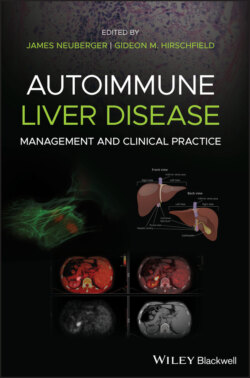Читать книгу Autoimmune Liver Disease - Группа авторов - Страница 32
Liver Regeneration
ОглавлениеLiver possesses a unique capacity to replace its mass after tissue injury or loss. The regenerative process involves a cascade of events that moves cells from their resting G0 phase through G1, S phase (DNA synthesis), and G2 to M phase (mitotic cell division). A typical example is hepatic growth after partial hepatectomy. The majority of research on liver regeneration has focused on cytokine‐ and growth factor‐ mediated pathways involved in initiation and progression through the cell cycle. During more extensive acute liver injury, which far exceeds the capacity of remaining healthy hepatocytes to replicate and restore liver function, resident liver progenitor cells (i.e. oval cells) are activated to support or take over the role of regeneration. In adults, there are multiple niches of biliary tree stem/progenitor cells (BTSCs) residing in different locations along the human biliary tree and niches found within the liver parenchyma, with a key role in regeneration of the liver. Figure 1.3 shows the location of stem/progenitor cell niches in the human biliary tree. Canals of Hering harbor hepatic stem/progenitor cells (HpSCs), while peribiliary glands (PBGs) constitute the niche for BTSCs.
Figure 1.3 Stem/progenitor cell niches in the human biliary tree. Canals of Hering harbor hepatic stem/progenitor cells (HpSCs), while peribiliary glands (PBGs) constitute the niche for biliary tree stem/progenitor cells (BTSCs). ASH, alcoholic steatohepatitis; BA, bile acid; CCA, cholangiocarcinoma; NAFLD, non‐alcoholic fatty liver disease; NAS, non‐anastomotic strictures; PSC, primary sclerosing cholangitis.
Source: Overi et al. [6].
Those within the biliary tree are found in PBGs and contain especially primitive stem cell populations, expressing endodermal transcription factors relevant to both liver and pancreas, pluripotency genes, and even markers indicating a genetic signature overlapping with that of intestinal stem cells [7]. The distribution of PBGs is not uniform, varying along the biliary tree: PBGs are mostly found in the hepatopancreatic ampulla and are less numerous in the common bile duct; they are not present in the gallbladder, but a stem cell‐like compartment is located in the epithelial crypts. Biliary progenitors support the renewal of large intrahepatic and extrahepatic bile ducts. Stem cells are present in the canals of Hering, and participate in the renewal of the small intrahepatic bile ducts and in the regeneration of liver parenchyma. Small hepatocytes located in pericentral positions are also believed to act as progenitor cells on certain occasions. Distinct subpopulations of mature hepatocytes and stem/progenitor cell compartments are differentially activated depending on the nature and duration of the liver damage versus different human pathologies.
